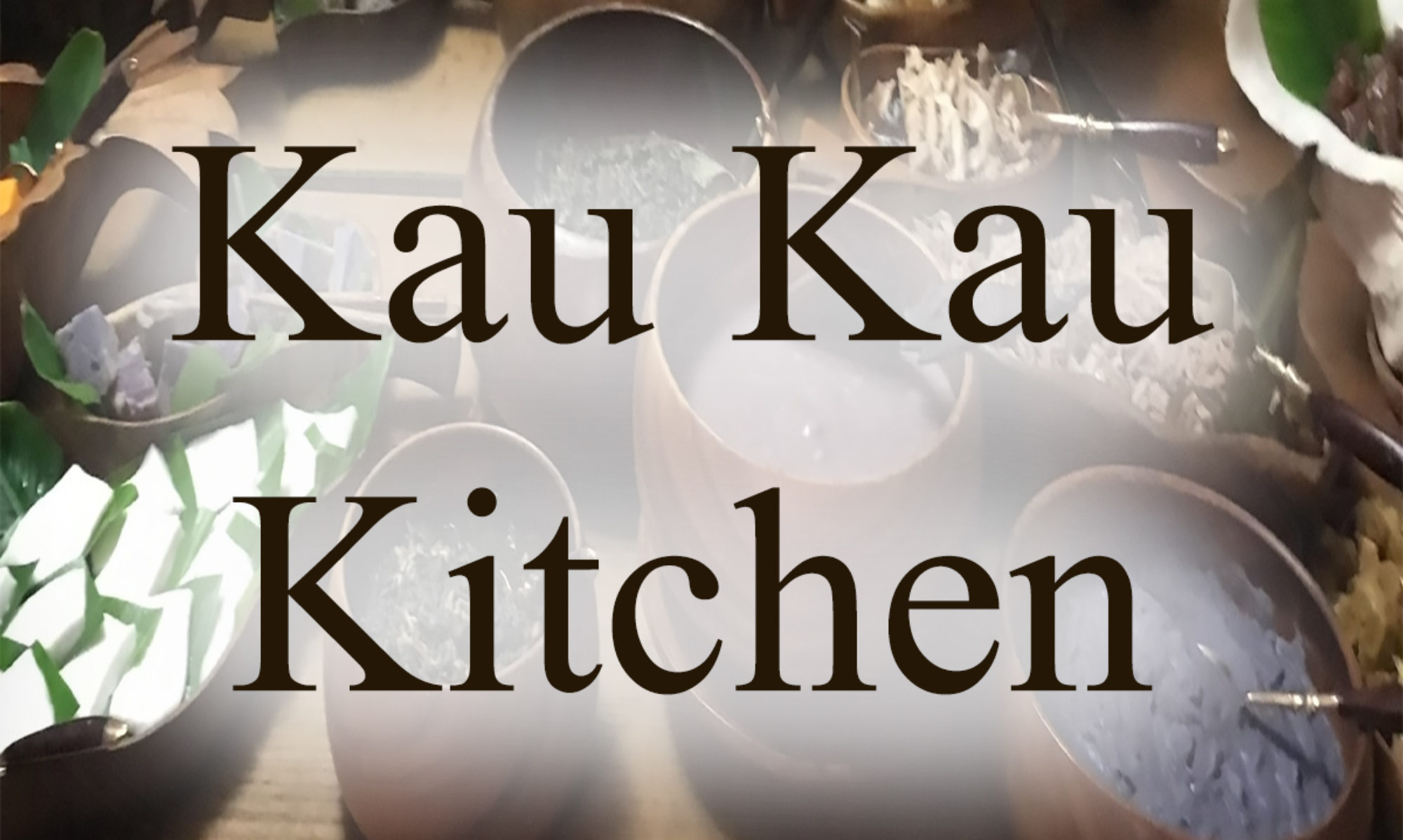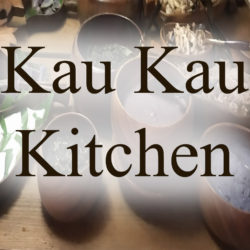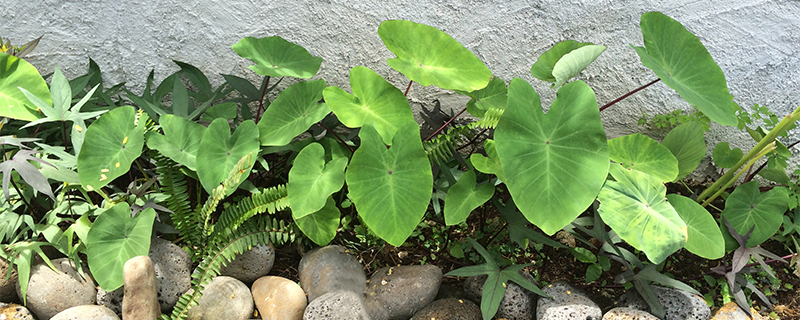Colocasia esculenta – An old-world tropical aroid cultivated and propagated since ancient times for food. Kalo is now found in all inhabited tropical regions. Kalo is a traditional Hawaiian staple since ancient times, and was developed by the Hawaiian farmers into more than 300 forms able to grow in the various climate and soil conditions found in the Hawaiian islands. All parts of the plant are eaten. The corm is used to make the Hawaiian staple, poi.
In my family, taro was generally boiled to at least partially cook before being made into a specific dish. One of our favorite ways to serve taro (other than as poi) was fried. My Nana always wet her knife before slicing kalo to help it slip through the corm rather than crumble it.
One of the problems with kalo is the calcium oxalate raphides (below) which cut through the cells of your mucus membranes and even, in those of us who are sensitive, skin.
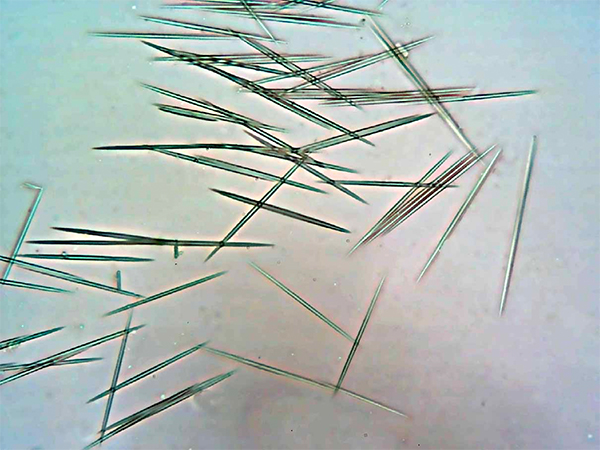
Depending on how sensitive a person is to the sharp little crystalline structures, they cause anything from a mild itching sensation to a burning and itching sensation akin to stinging nettles. I am on the more sensitive end of the spectrum, so even getting the juice of raw kalo on my hands while harvesting or cleaning causes intense pain.
Recently, I was cleaning freshly harvested kalo to steam it and forgot to put on my gloves and boroboro long-sleeve shirt. AUE!!!! So itchy and sore everywhere the juice splattered me! Well, that inspired me to share with you how I deal with the itching and burning. For skin, wash with the hottest water you can stand and scrub with baking soda. Repeat until the irritation subsides. And, remember, “An ounce of prevention is worth a pound of cure!” Wear kitchen gloves and an old long-sleeve shirt to protect yourself!
A person may also accidentally be afflicted in the mouth if, for example, checking to see of the lūʻau or kalo is ready. Also, children or pets may bite into kalo out of curiosity. Here is what I have found to be the most effective way to deal with that: Take a spoonful of table salt in your mouth and use your tongue to rub it all over the itchy places. You will drool like crazy. SPIT OUT THE DROOL! Repeat until the irritation subsides.
So, before anything else can be done with the kalo, it must first be cooked!
Now, if you are interested in learning to make poi, enjoy this video from TheCocoNet:
Fried Taro
- kalo
- water
- butter
- pepper
- salt
Boil the kalo until you can pierce it with a fork. Peel off the `ili (skin), being careful to keep the flesh clean. Using a sharp knife which has been wetted, slice the corm into 1/2 inch thick rounds. Sprinkle with ground black pepper and a little salt. Fry in butter until a crispy shell forms on the outside, and the inside is tender.
Taro Croquettes
Croquettes are tasty little fried cakes which can be made of just about anything. The outside should be delicate and crispy, while the inside is smooth and creamy. During WWII, Hawai`i housewives, already used to frugality in the kitchen, adapted croquette recipes to local leftovers. Among the new treats was taro croquettes.
- 1 small onion
- butter
- 2 cups leftover cooked taro, mashed fine
- 1 egg
- 2 tablespoons flour
- Parsley or other favored herbs, minced
Mince the onion and saute in the the butter. Let cool and add to the taro, egg, flour, and herbs. Mix thoroughly. Form mix into small patties or rounds and fry in 3″ hot oil until golden. Sprinkle with a little salt and pepper. Drain. Serve hot
Palusami
This Samoan dish is popular with all ethnic groups throughout the islands.
20 (or so) lu`au (young taro leaves)
2 cups coconut cream
1 lemon, juiced
2 onions, minced
salt to taste
Wash the leaves thoroughly and set aside. Mix together the coconut cream, lemon juice, and minced onions. Add salt to taste. Make a bowl of 3-5 small leaves and fill with about 1/2 cup of the coconut mix. Fold the lu`au around the mix so that it makes a packet. Wrap in aluminum foil so that it will not spill. Place the packets in a baking dish lined with ti leaves or foil (to aid in washing up!) and bake at 300 degrees F for 2 hours or so, until there is no itchiness left in the lu`au. Let cool a bit, remove foil and serve.
Poi Cocktail
A refreshing drink which is also soothing when you are ill. I grew up considering a poi cocktail as good as a milkshake. Now I think they are better! My grandmother made it for me when I was a little girl and had my tonsils removed.
1 cup milk, coconut milk, rice milk, or whatever you prefer
1/4 cup poi, or to taste
sugar to taste
cinnamon, nutmeg to taste
Simply beat the mix with a fork and serve!
Taro Chips
Taro chips have become very popular. And expensive! Here is one recipe for them.
Boil whole unpeeled taro till cooked through. Chill. Then slice as thin as possible. Fry in hot oil until crisp (about 10 minutes). Use frying pan or deep fryer. Drain on cake rack, absorbent paper or newspaper, and sprinkle with salt or garlic salt.
Parts of the Kalo Plant
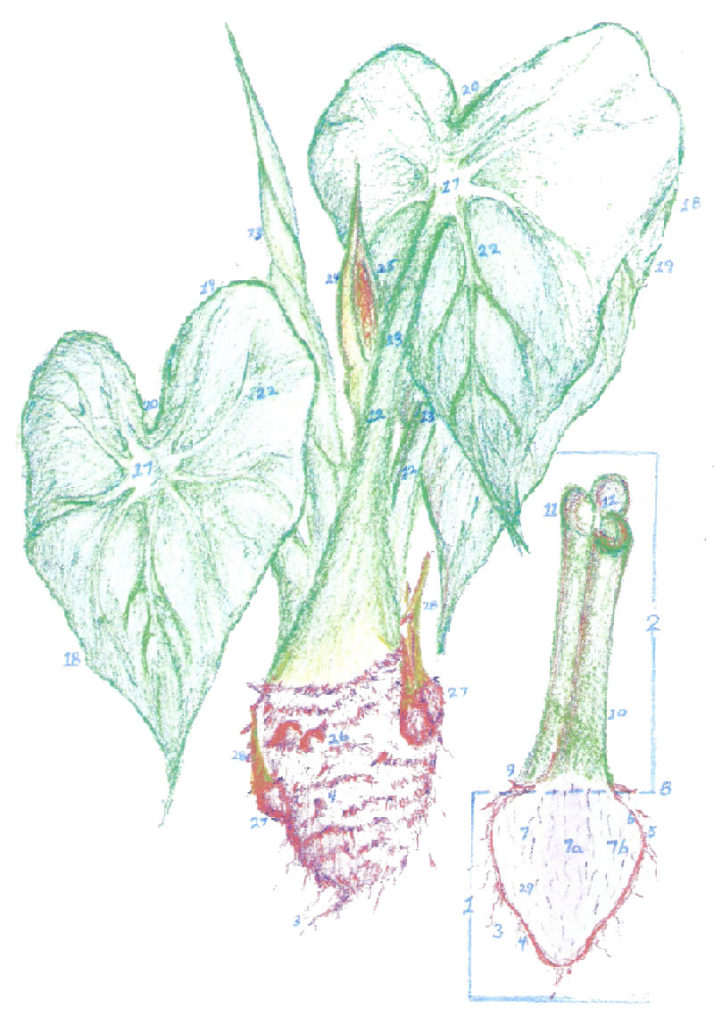
2) huli – seed stalk for planting
3) a`a – rootlets
4) huluhulu – non-rootlet hairs on corm
5) `ili kalo – skin of corm.
6) `ili kana – cortex
7) i`o kalo – flesh of corm
7a) iho kalo / poi he – core of corm used to make poi for chiefs
7b) i`o kalo / poi `ili – outer portion of corm used to make regular poi
8) kohina – cutting line. Where the corm is removed from the stalk to create the huli
9) kumu ha – petiole base
10) ha – petiole
11) `ili ha – epidermis of petiole
12) mawae – petiole sheath
13) lihi mawae – margin of petiole sheath
17) piko – junction of petiole and blade
18) lau – leaf
19) ka`e lau – edge of leaf blade
20) mahae – basal indentation
22) a`a lau / iwi – leaf midrib and veins
23) ao lu`au / lu`au / mohala – young furled leaf blade
24) pua – inflorescence or blossom
25) iho / `ikoi pua – spadix
